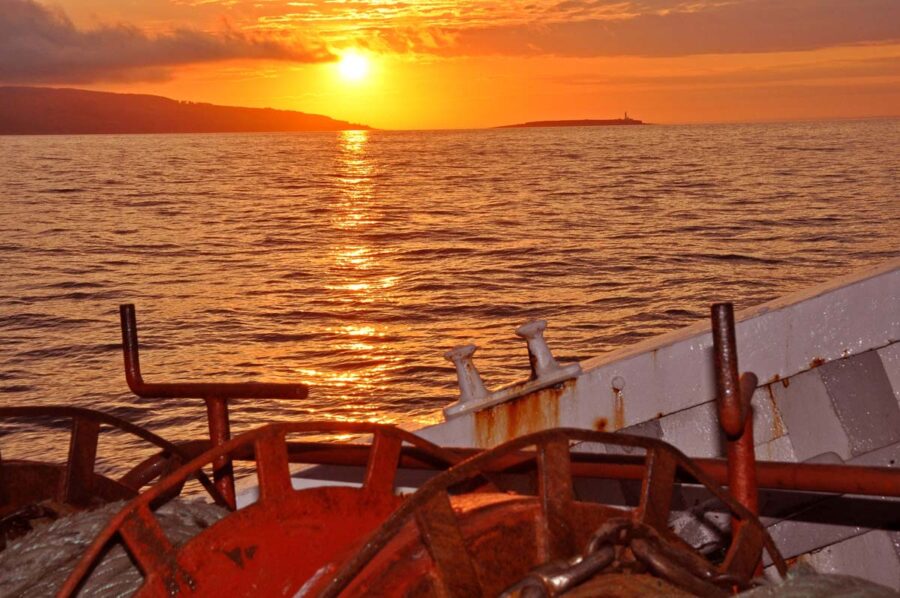David Linkie looks back to 2012 and a trip on the Campbeltown twin-rig trawler Shangri-La CN 394
The distinctive high-rounded profile of Davaar Island was just beginning to gain clarity against the first signs of a slowly lightening sky as Shangri-La joined a succession of 10 trawlers stretching more than a mile ahead down Campbeltown Loch towards the Clyde prawn grounds.

01. Shangri-La.
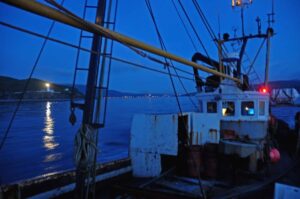
02. Shangri-La heads down Campbeltown Loch towards Davaar at 3am.
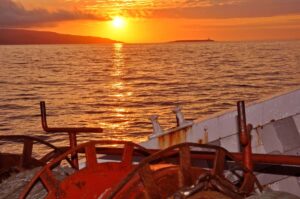
03. The sun rises over the southern tip of the Isle of Arran and Pladda lighthouse, two hours after Shangri-La left Campbeltown harbour.

04. Shangri-La’s 460-mesh prawn hopper trawls were rigged on 20ft of 12in hoppers in the bosum section.
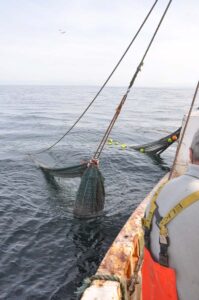
05. Taking the starboard bag aboard.

06. Releasing the port codend.
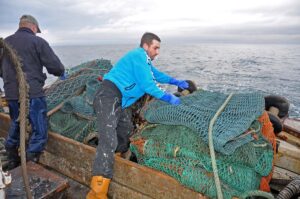
07. Ramunas and Thomas drop the codends over the transom.
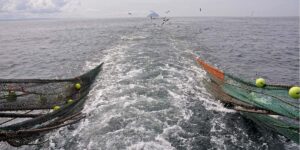
08. Streaming Shangri-La’s twin-rig prawn hopper trawls.
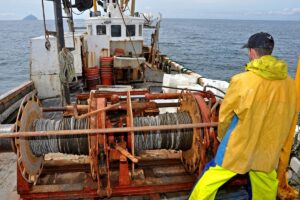
09. Hauling back the wires at the end of the first tow.
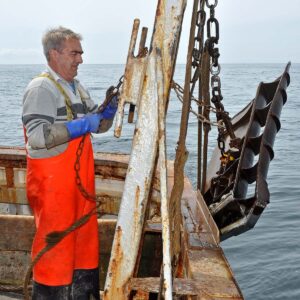
10. Robbie McVea chains up the port side Bison door.
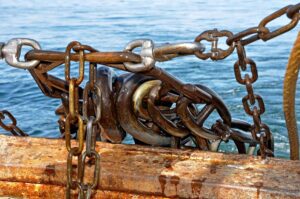
11. The 150kg chain clump is lifted to the transom using the 50-fathom splits.
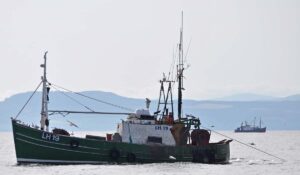
12. The Troon prawn trawlers Silver Crest and Dawn Watch towing east of Arran.
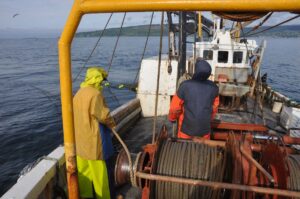
13. Hauling the split Gilson ropes south of Holy Isle.
With a similar number of boats breaking away from the quays to drop in astern of local skipper Richard Johnston’s Shangri-La, this provided an initial indication of the level of prawn fishing activity in the Clyde that Campbeltown was supporting at the time of this trip in mid-June 2012. In addition to some 10 local Kintyre-owned trawlers, up to 40 visiting vessels from the Co Down harbours of Portavogie, Ardglass and Kilkeel were leaving Campbeltown Loch each weekday morning around 3am.
On clearing Davaar light, Shangri-La held a more easterly heading to steam across Kilbrannan Sound towards the Pladda Island grounds on the western side of the Clyde. All of the Co Down trawlers could be seen off the starboard side heading more into the southeast and the cleaner-bottom Ailsa Craig grounds.
Although Richard Johnston, together with other skippers, had been able to shoot the trawl and begin towing within 30 minutes of leaving the mouth of Campbeltown Loch the previous week, constantly changing water and tidal conditions had resulted in a poor first haul on two mornings at the beginning of a new week – an outcome that clearly required a revised action plan.
While some local skippers opted to spend their day in Kilbrannan Sound, two and a half hours had passed before Shangri-La’s crew were called in preparation for shooting away the twin-rig prawn hopper trawls. Having left the uninhibited Pladda astern and rounded Dippin Head on the southeast tip of the Isle of Arran, Shangri-La crossed over an area of poor peaky bottom, which the Furuno sounder indicated shoaled up to 20 fathoms.
Immediately Shangri-La had cleared the shaded area of ground displayed on the plotter and was in some 60 fathoms of water, the speed of the Volvo Penta engine was throttled back before crewmen Ramunas and Thomas pushed the codends over the stern, quickly followed by the 14in hopper ground gear.
Towing the nets from the trawl gallows for a few seconds to check that the gear had been shot cleanly, before the sweeps were released from the trawl winch, provided an opportunity to gauge the smallness of the prawn trawls used by Shangri-La, and typically by most of the local Clyde fleet. In order to further reduce the already extremely low numbers of juveniles retained, large mesh was used in the top sheet – a feature that also brought fuel savings.
With the winch breaks applied as the 100-fathom marking (after the 50-fathom splits) became visible, the 14mm-diameter wire was quickly chained up before Shangri-La started to tow northwards across Whiting Bay towards the Holy Isle.
Two other Campbeltown boats, Atlas and Marigold, were towing three miles to the north, while a third, Silver Lining, was working nearer to Pladda. The Co Down trawlers were just discernible on the skyline, working east and west to the south of the Ailsa Craig 14 miles distant.
A number of boats that had left Troon harbour on the Ayrshire coast shortly after Shangri-La got underway were towing a few miles to the east in the Arran Trench nearer the middle of the Clyde.
On opening up Clauchlands Point north of Holy Isle, Shangri-La turned to starboard two hours into the first tow of the day. Seventy-five minutes later, the hydraulics were engaged in in preparation for lifting the gear. The previous morning, the first haul in a similar area had yielded a good return, but with a significantly stronger tide running, optimism was fairly muted – not least because seldom, if ever, are consecutive days of prawn fishing the same in the Clyde. This variability has long been recognised as one of the most consistent features of the fishery. At the same time, it is one of its perverse strengths, due to the constant need for effort diversity.
As the toe-ends of the twin-rig trawls were hauled to the blocks, Shangri-La came round to starboard and the gear as the codends were hauled forward by the split dog ropes. Releasing the starboard codend resulted in an estimated four baskets of clean prawns cascading onto the deck.
After this codend was stropped off forward, the port bag was quickly lifted onboard to reveal a similar return. Although not as successful as the comparable tow 24 hours earlier, it was considered a reasonable start – particularly with a slack water tow, which can improve catch rates, particularly during a run of bigger tides, still to come.
With Shangri-La starting the second tow on a southerly heading into the flood towards the west side of a distant Ailsa Craig, the prawns were quickly picked up off the deck into baskets, before being tipped in turn onto the sorting table in the starboard shelter. Making two selections of heads in addition to a decent class of tail (average 90 count per kg) resulted in crewmen Robbie, Ramunas and Thomas washing six baskets of medium prawns, two of large and one of tails.
Although a group of seven Troon trawlers had taken their first tow of the morning in relatively close proximity to one another some four miles east of Shangri-La, by 11am and probably beyond the midpoint of their second tow, they were well dispersed. This was taken as an indication that their first lifts had been nothing special, and that their skippers were now trying something slightly different, in the same way that Richard Johnston was doing.
Having commenced in a water depth of 65 fathoms, the second tow came to an end three hours later in 50 fathoms. Aware that slack water was rapidly approaching, Shangri-La had altered course into the northwest for the last part of the tow, in order to shorten the distance to where skipper Richard Johnston wanted to shoot away again, closer in towards Pladda.
Lifting the codends aboard for the second time revealed a similar level of catch, so the pressure for a more productive third tow across the high-water slack was increased.
This got underway towing into the northwest just over a mile from the shore, in 50 fathoms of water. For the first part, Shangri-La was on a reciprocal course to that being followed by another Campbeltown twin-rig trawler, skipper Andrew Harrison’s Atlas CN 258, which having shot closer inshore to the north, initially towed into the southeast before coming round onto a similar heading as Richard Johnston had set on the Cetrek 9000 autopilot.
After 90 minutes, Shangri-La came round to starboard before starting to stem up Ailsa Craig, some nine miles distant. While Atlas continued to tow northwards, two under-10m Troon trawlers, Serinah and Tay-Lee, were now towing on a parallel heading a relatively short distance off Shangri-La’s port quarter, illustrating the extent to which vessels come and go during the course of a day’s fishing in the Clyde.
Shortly before 4pm, the gear was hauled back at the same time as the two-year-old Maltese-flagged 196m/34,374GT bulk carrier Thalassini Kyra, inward-bound for Glasgow, passed down Shangri-La’s starboard side. The constant presence of commercial shipping, including high-speed ferries on the Northern Ireland run, is something that Clyde skippers need to be constantly aware of.
As hoped, the slack water had resulted in a slightly higher catch rate which, on picking up off the deck, filled nine baskets. While not spectacular, this represented another step in the right direction, highlighting the importance of steady accumulation in what is characteristically a low-impact fishery.
With the ebb tide now running strongly, the concluding tow of the day came to its planned end two hours later, by which time the return distance to Campbeltown, some two hours’ steaming time to the west, had been shortened by a couple of miles.
On releasing the smallest catches of the day onto the starboard side deck, the trawls were run through the powerblock before the ground gear was lifted up and laid on the quarter, followed by the remainder of the net.
With 12 boxes of medium and three of larger heads-on prawns, together with one and a half boxes of tails, ready to land to Scot-Prime, Shangri-La followed the Co Down trawlers Faithful Friend V, Supreme, Argent, Starlight Splendour and Silver Dee up Campbeltown Loch shortly before 8pm, at the end of a fairly representative 17-hour day – which would start to be repeated again in little over six hours.
Anstruther-built Shangri-La
The 16.5m wooden-hulled Shangri-La was built by Smith & Hutton at Anstruther in 1967 as the transom-sterned dual-purpose seiner/trawler Shangri-La KY 372 for Pittenweem skipper James Anderson.
After performing well on popular whitefish grounds off southeast Scotland known as the Wee Bankie before landing prime-quality fresh fish into Pittenweem, Shangri-La crossed the Firth of Forth after being bought by Dunbar skipper Robert Johnston. Re-registered LH 327, Shangri-La engaged in seasonal late-autumn sprat fishing on the local grounds – when midwater pair-trawling with another similar-sized Dunbar trawler, skipper David Fairbairn’s Highland Queen LH 62 – together with prawn/whitefish trawling.
Shangri-La left southeast Scotland for Northern Ireland in 1984, when the boat was bought by Portavogie skipper Norman Kelly. After fishing in the Irish Sea for 11 years, Shangri-La was sold to Duncan McIntosh of Carradale.
Skipper Richard Johnston purchased Shangri-La in 1996, since when the trawler fished prawns from Campbeltown, working the local grounds around Islay, Jura and Gigha to the west of the Kintyre peninsula and eastwards round the Mull to the Clyde and Kilbrannan Sound.
Shangri-La was fitted with a new 179kW Volvo Penta TMD102A engine in 2004, which drives a five-bladed 48in-diameter propeller through a Twin Disc 4.8:1 reduction gearbox.
A few years after this trip, Shangri-La was sold to Kilkeel and renamed St Joseph N 394.
Successful twin-rig trawling with splits
Campbeltown skipper Richard Johnston’s 16.5m Shangri-La was one of a number of similar-sized trawlers equipped with two-drum trawl winches to use two warps and splits, rather than a dedicated middle wire, to work twin-rig prawn hopper trawls.
Using splits to facilitate twin-rig trawling is reported to work well and meet the needs of Campbeltown/Clyde skippers, who spend most of their year working small hopper trawls on catchy bottom and along ground edges for a generally better class of head-on prawn, rather than using a bigger grassrope trawl on cleaner ground to take a higher percentage of smaller Nephrops which are subsequently tailed.
Skipper Richard Johnston first started to use splits in 2000 following extensive and successful Seafish trials, when Scanmar sensors fitted to the doors and wing ends of each net provided accurate data for the relative spreads, while height sensors on each net indicated the standing of the headline. In order to provide full transparency of the strain on the gear in order to allow fine-tuning and even balance, underwater load cells were fitted on each split warp, in addition to tension meters on the main wires from the towing point on Shangri-La.
The trawler was towing two 460-mesh prawn hopper trawls supplied by Port Seton netmaker Alex Harkness, whose popular and successful design of prawn trawls were widely used by this class of vessel. The nets were rigged on 62ft sole ropes, with 20ft of 12in hoppers in the bosom section.
Eighteen-fathom splits, comprising seven fathoms of wire and rubber leg splits, followed by 10 fathoms of 28mm-diameter combination, were used to attach the prawn hopper trawls to a set of Bison size 5 trawl doors.
Fifty fathoms of 14mm split warps were used to attach the trawl doors and a 150kg chain clump to the two outer wires of the same diameter. With 100 fathoms of outer wire shot in front of the splits in 50 fathoms of water, this arrangement gave a typical door spread of 115ft, increasing to 130ft with 175 fathoms of wire shot in a depth of 80 fathoms.
Although the spread between the doors varied according to the depth of water and the amount of wire shot, the spread at the splits (46ft) and wing ends (19ft) was more consistent. The sweep angle usually varied between 13° and 15° – fairly typical for a prawn hopper vessel of this size.
During the initial Seafish trial – since which time skipper Richard Johnston continued to use a similar arrangement of gear, on the basis: “Why change anything if it continues to work well?” – the spread at the point where the split warps joined the main warps only varied from 14m to 15m throughout all the variations of warp length/depth of water – a distance that was always between 38% and 40% of the overall door spread. The extension required in the outer split warp to achieve maximum fishing efficiency varied from 1ft to 3ft 6in, depending on the door spread and the amount of warp shot.

